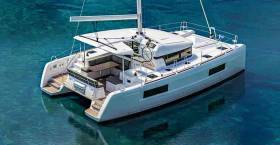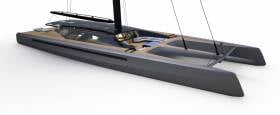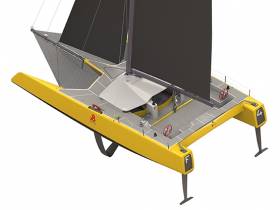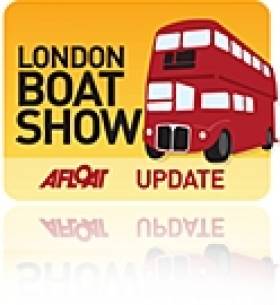Displaying items by tag: Catamaran
Catamaran Sailing: Ever Dreamed of a Year off in the Caribbean?
Mark Mansfield, Irish Agent for Nautitech Catamarans (plus Grand Soleil yachts and J Boats), presents a video/webinar from a client of Key Yachting who has done just that.
UK sailor David McLeman bought a new Nautitech 46 Open Catamaran from Key Yachting in order to fulfil his dream of cruising in Europe plus doing the ARC Transatlantic cruise/race and spending a full year away in the Caribbean.
Choosing a catamaran
The video below covers his reasons for choosing a catamaran, even though he was previously a monohull sailor including competing in a number of Fastnet Races.
Key Yachting presently has a demo Nautitech 46 open for sale, only new last July. This boat is fully equipped, in the water at Hamble, and ready to sail away. It is being offered at €498,000—plus VAT, a €60k plus VAT discount off the new price.
Questions answered in this video are:
-
Why a multihull over a monohull?
-
Monohull—sailing performance versus more accommodation?
-
What size monohull has similar internal volume compared to a multihull?
-
How many crew are needed to do a trip like this?
For further details of any of the Nautitech range, or indeed the Nautitech 46 open for sale at Key Yachting, contact Mark Mansfield at [email protected] or by phone at 00 353 87 2506838.
Also see: 2019 NAUTITECH 46 OPEN for sale
Clogherhead Lifeboat Rescues New Zealand Catamaran & Crew
#RNLI - Clogherhead RNLI had a late-night callout on Wednesday 1 August to rescue the crew of a yacht that had got into difficulty.
At around 10.10pm, the Co Louth village’s all-weather lifeboat was requested by the Irish Coast Guard to go to the aid of a yacht that had become entangled in ropes some two-and-a-half miles north of Dunany Point.
The lifeboat quickly located the 45ft catamaran from New Zealand and helped free the vessel before towing it to safety in Port Oriel, where it was tied up at the pier around 1.20am.
New Lagoon Catamaran 40 Ready For Autumn Unveil
A new Lagoon catamaran 40 model will be available this Autumn.
Builders say the new size represents a combining of two Lagoon generations, the 39 and 400. The new yacht has aft rigging for greater performance and a self-tacking jib for easier manoeuvring.
The cockpit, like the highly successful 42, has a well-thought out interior by Nauta Design. The new 40 is available with three or four cabins.
Lagoon is also offering a new 50–footer. With its two new models, Lagoon now offers a full line of catamarans from 38 to 77 feet.
The model is available from yacht brokers MGM Boats Ltd in Ireland.
Pre–Owned Multihull Boat Show Next Month in France
The second edition of the Pre-owned Multihull boat show takes place in Canet-en-Roussillon in the South of France near the Spanish border.
The show is an indication of the growing demand for multihulls coming from owners seeking longer live–aboard opportunities.
The Nautipole and boat show organiser M2O will exhibit about 30 pre-owned power and sailing catamarans from 37 to 82 feet on the pontoons of the Yacht harbour. An exhibitor village will offer multihulls services and equipment.
The event runs from Thursday October 6th to Sunday 9th in the Yacht harbor of Canet-en-Roussillon.
The shows opening hours to the public are from 10 am to 6 pm. Entry is free.
BlackCat Large Luxury Cruising Catamaran Builders Will Be At Monaco Boat Show
BlackCat Superyachts has announced an alliance with a selection of the industry’s leading suppliers in the large luxury cruising catamaran market.
Founded in 2015 by Mitch Booth, BlackCat Superyachts are a new breed of catamarans.
Baltic Yachts is the world’s leading boatbuilding yard specialising in high performance carbon fibre yachts custom made to meet customers' needs in design, performance and technical innovation.
North Technology Group (a global industry leader that includes North Sails, Southern Spars and Future Fibers) are recognised as a world leader in sailmaking, rigging and spar construction and offers BlackCat a fully integrated, high-performance solution by using the North Design Suite, a powerful set of analytical tools that allow sail, rig and yacht designers to analyse loads and improve boat performance.
M2 Atelier, the international architecture and interior design studio, will provide the sleek styling and finishing details.
The BlackCat brand is strengthened substantially with this group of premium suppliers and together with Malcolm McKeon Yacht Design, one of the world’s most successful superyacht designers, BlackCat Superyachts aims to produce the next generation of sleek, state-of-the-art and high performance multihull superyachts.
Malcolm McKeon, BlackCat’s chief designer, said: “We are extremely pleased to announce the partnership of BlackCat with these leading superyacht design and engineering companies. Bringing in the vast experience of these well-respected establishments enables us to further push the boundaries of innovative bespoke solutions and to create the yacht of our clients’ dreams in a design that is unique in the market. The BlackCat combines an enormous, stable platform with exhilarating performance, resulting in a high-performance carbon-fibre ‘supercat’ where the latest building technology and materials will be used.”
“There is no such thing as a production yacht and each owner is looking for something that matches their vision,” said Jeremy Elliot, North Sails designer. “North Design Suite makes it possible to find solutions to problems unique to each build. The North Technology Group structure allows North and Southern to share design resources to deliver the most progressive sail and rig plan possible.”
“We are very proud to be part of this extraordinary team in such a unique project", added Marijana Radovic, BlackCat interior designer from M2 Atelier, “We try to integrate and connect the interior design with the lines, characteristics and performances of the exterior design in order to achieve a continuous atmosphere and energy throughout the project. Contemporary, lightness, comfort and luxury blend together in these one-of-a-kind spaces that any superyacht owner expects to see. Technology and craftsmanship are balanced in every aspect of the design to create exceptional spaces, where details typically used on superyachts are combined with residential solutions and generous proportions to create the most unique ‘Sea-Loft’ of all time”.
BlackCat now offers a turnkey package on the 50 Metre version - the largest single structure carbon-fibre yachts in the world. The long period of design, engineering, construction study, materials and pricing is now complete and ready for production. This package provides the client with an accurate pricing and transparent build process in order to save time and money. There are still possibilities to custom design the internal layout of each BlackCat 50 and a variety of external features to give every boat a custom made distinctive style and finish.
BlackCat Superyachts will be present at the Baltic Yachts QH33 exhibition stand at the Monaco Yacht Show from 28 September to 1 October.
Hot on the heels of its F1 A-Class catamaran, DNA Dutch builder has announced the F4, the first foiling offshore one-design catamaran.
The DNA F4 is a full carbon 46-foot foiling catamaran designed and built to push the boundaries of distance one design racing offshore. Built in Lelystad, the boat is the result of an 8-month design project spearheaded by DNA’s engineer and Shannon Falcone. The plan is to launch and commission in Newport, RI in summer 2016 and spend the remainder of autumn in New England testing the boundaries of the boat’s capabilities in preparation for a busy winter racing season in the Caribbean.
Aimed at those looking for America’s Cup technology without the need for large shore crews and being washed from trampolines, the F4’s cockpit offers ample room for passengers in the heart of the action with a pilothouse providing sheltered area for long passages.
“With the design cycle of the F4, the focus was all on performance and the result is stunning, a bigger and faster all-out racing machine which every speed freak should at least have a look at,” says Pieterjan Dwarshuis.
New Foiling Vampire Catamaran Hits 30–knots Downwind
With an aim to make a mark on the future of foiling sailing, the British foiling Vampire catamaran project has already reached peak speeds downwind of 30–knots.
The project is a collaboration between catamaran sailor William Sunnucks and boat builder Graham Eeles to develop a new breed of foiling catamaran in Brightlingsea Essex. The design, they say, is based on the the International Moth foil design which is quite different to the America's Cup line of development.
On a day that proved exciting for all, Timbalero III was flying on the downwind leg of the course at the Voiles de Saint Barths regatta on the east side of the island when the bright orange, futuristic foiling cat tripped up and capsized.
"It was such a silly mistake," said Peter Johnstone, Gunboat's founder and G4 crew member. "A gust hit us and for some reason we didn't dump the mainsheet and she just carried on heeling."
More on this capsize here by Matthew Sheahan in Yachting World
Three Dead In Catamaran Capsize Off Costa Rica
#Capsize - Three people are reported dead after a tourist catamaran capsized off Costa Rica, as the Guardian reports.
The incident, which occurred yesterday (8 January) some nine miles off the Central American country's Pacific coast, is thought to have claimed the lives of a Briton, an American and a Canadian.
Survivors from the boat, carrying nearly 100 tourists and 10 crew on a day trip to Tortuga Island, say it was swamped by strong waves that quickly filled the vessel with water.
The Guardian has more on the story HERE.
See Foiling Catamaran at Tomorrow's London Boat Show
#londonobatshow – A first for tomorrow's London Boat Show is the real-time build of a 5.9m sailing catamaran with a cutting-edge hydrofoil system developed by Southampton Solent University. Afloat first reported on the new British foiling cat last September when she made her UK debut.
The first production model of the 'Solent Whisper', which has already turned heads at both the PSP Southampton Boat Show and the Paris International Boat Show, will take shape before the eyes of the media and the public. The retail version of the craft, which comfortably achieves over 25 knots and incorporates a revolutionary new hydrofoil system, is being manufactured by White Formula UK Ltd.
Helena Lucas, Paralympic Gold medallist and graduate of Southampton Solent University, has sailed the prototype boat and will be on hand at The Datatag Lab to help 'launch' the catamaran building activities on Friday 9 January at 1.45pm.
Visitors will be able to watch all the stages of production from the preparation of the moulds, to the final infusion of resin into the carbon fibre of the boat.
The new hydrofoil technology is the brainchild of Ron Price, a Southampton Solent University yacht and powercraft design graduate who is now Senior Lecturer in Naval Architecture at the University's Warsash Maritime Academy.

































































